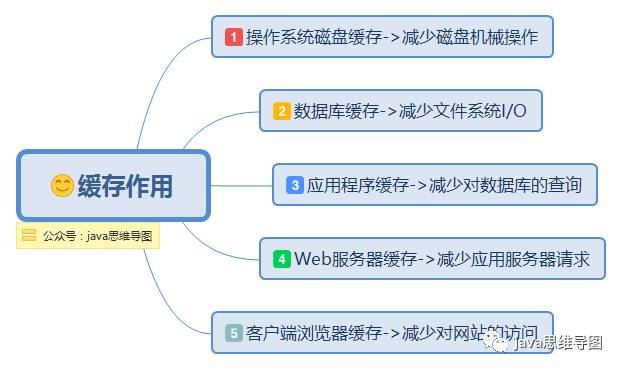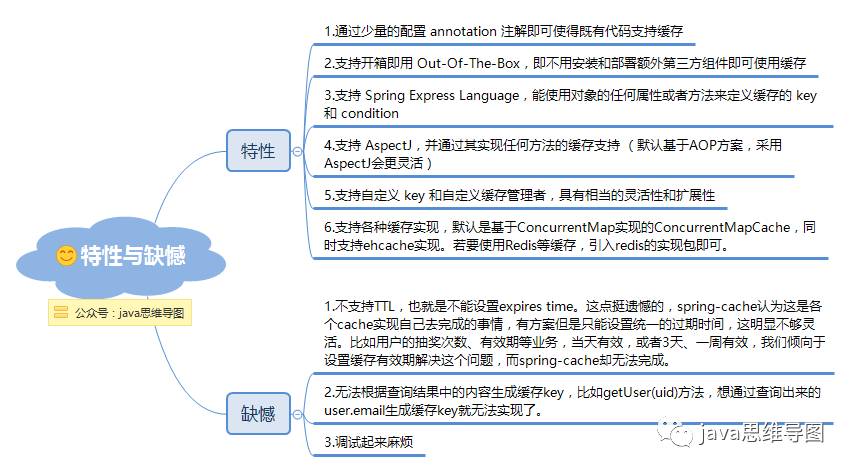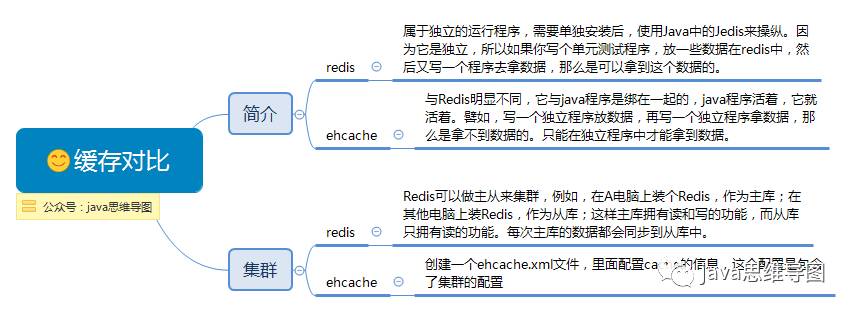缓存是实际工作中非常常用的一种提高性能的方法。而在java中,所谓缓存,就是将程序或系统经常要调用的对象存在内存中,再次调用时可以快速从内存中获取对象,不必再去创建新的重复的实例。这样做可以减少系统开销,提高系统效率。
在增删改查中,数据库查询占据了数据库操作的80%以上,而非常频繁的磁盘I/O读取操作,会导致数据库性能极度低下。而数据库的重要性就不言而喻了:
数据库通常是企业应用系统最核心的部分
数据库保存的数据量通常非常庞大
数据库查询操作通常很频繁,有时还很复杂
在系统架构的不同层级之间,为了加快访问速度,都可以存在缓存

缓存不同层级的作用.png
现在市场上主流的缓存框架有ehcache、redis、memcached。spring cache可以通过简单的配置就可以搭配使用起来。其中使用注解方式是最简单的。

特性与缺憾.png

缓存注解.png
从以上的注解中可以看出,虽然使用注解的确方便,但是缺少灵活的缓存策略,
缓存策略:
TTL(Time To Live )
存活期,即从缓存中创建时间点开始直到它到期的一个时间段(不管在这个时间段内有没有访问都将过期)TTI(Time To Idle)
空闲期,即一个数据多久没被访问将从缓存中移除的时间
项目中可能有很多缓存的TTL不相同,这时候就需要编码式使用编写缓存。
根据运行流程,如下@Cacheable将在执行方法之前( #result还拿不到返回值)判断condition,如果返回true,则查缓存;
@Cacheable(value = "user", key = "#id", condition = "#id lt 10")
public User conditionFindById(final Long id)如下@CachePut将在执行完方法后(#result就能拿到返回值了)判断condition,如果返回true,则放入缓存
@CachePut(value = "user", key = "#id", condition = "#result.username ne 'zhang'")
public User conditionSave(final User user)如下@CachePut将在执行完方法后(#result就能拿到返回值了)判断unless,如果返回false,则放入缓存;(即跟condition相反)
@CachePut(value = "user", key = "#user.id", unless = "#result.username eq 'zhang'")
public User conditionSave2(final User user)如下@CacheEvict, beforeInvocation=false表示在方法执行之后调用(#result能拿到返回值了);且判断condition,如果返回true,则移除缓存;
@CacheEvict(value = "user", key = "#user.id", beforeInvocation = false, condition = "#result.username ne 'zhang'")
public User conditionDelete(final User user)小试牛刀,综合运用:
@CachePut(value = "user", key = "#user.id")
public User save(User user) {
users.add(user);
return user;
}
@CachePut(value = "user", key = "#user.id")
public User update(User user) {
users.remove(user);
users.add(user);
return user;
}
@CacheEvict(value = "user", key = "#user.id")
public User delete(User user) {
users.remove(user);
return user;
}
@CacheEvict(value = "user", allEntries = true)
public void deleteAll() {
users.clear();
}
@Cacheable(value = "user", key = "#id")
public User findById(final Long id) {
System.out.println("cache miss, invoke find by id, id:" + id);
for (User user : users) {
if (user.getId().equals(id)) {
return user;
}
}
return null;
}
spring cache集成ehcache,spring-ehcache.xml主要内容:
<dependency>
<groupId>net.sf.ehcache</groupId>
<artifactId>ehcache-core</artifactId>
<version>${ehcache.version}</version>
</dependency><!-- Spring提供的基于的Ehcache实现的缓存管理器 -->
<!-- 如果有多个ehcacheManager要在bean加上p:shared="true" -->
<bean id="ehcacheManager" class="org.springframework.cache.ehcache.EhCacheManagerFactoryBean">
<property name="configLocation" value="classpath:xml/ehcache.xml"/>
</bean>
<bean id="cacheManager" class="org.springframework.cache.ehcache.EhCacheCacheManager">
<property name="cacheManager" ref="ehcacheManager"/>
<property name="transactionAware" value="true"/>
</bean>
<!-- cache注解,和spring-redis.xml中的只能使用一个 -->
<cache:annotation-driven cache-manager="cacheManager" proxy-target-class="true"/>spring cache集成redis,spring-redis.xml主要内容:
<dependency>
<groupId>org.springframework.data</groupId>
<artifactId>spring-data-redis</artifactId>
<version>1.8.1.RELEASE</version>
</dependency>
<dependency>
<groupId>org.apache.commons</groupId>
<artifactId>commons-pool2</artifactId>
<version>2.4.2</version>
</dependency>
<dependency>
<groupId>redis.clients</groupId>
<artifactId>jedis</artifactId>
<version>2.9.0</version>
</dependency><!-- 注意需要添加Spring Data Redis等jar包 -->
<description>redis配置</description>
<bean id="jedisPoolConfig" class="redis.clients.jedis.JedisPoolConfig">
<property name="maxIdle" value="${redis.pool.maxIdle}"/>
<property name="maxTotal" value="${redis.pool.maxActive}"/>
<property name="maxWaitMillis" value="${redis.pool.maxWait}"/>
<property name="testOnBorrow" value="${redis.pool.testOnBorrow}"/>
<property name="testOnReturn" value="${redis.pool.testOnReturn}"/>
</bean>
<!-- JedisConnectionFactory -->
<bean id="jedisConnectionFactory" class="org.springframework.data.redis.connection.jedis.JedisConnectionFactory">
<property name="hostName" value="${redis.master.ip}"/>
<property name="port" value="${redis.master.port}"/>
<property name="poolConfig" ref="jedisPoolConfig"/>
</bean>
<bean id="redisTemplate" class="org.springframework.data.redis.core.RedisTemplate"
p:connectionFactory-ref="jedisConnectionFactory">
<property name="keySerializer">
<bean class="org.springframework.data.redis.serializer.JdkSerializationRedisSerializer"></bean>
</property>
<property name="valueSerializer">
<bean class="org.springframework.data.redis.serializer.JdkSerializationRedisSerializer"/>
</property>
<property name="hashKeySerializer">
<bean class="org.springframework.data.redis.serializer.JdkSerializationRedisSerializer"/>
</property>
<property name="hashValueSerializer">
<bean class="org.springframework.data.redis.serializer.JdkSerializationRedisSerializer"/>
</property>
</bean>
<!--spring cache-->
<bean id="cacheManager" class="org.springframework.data.redis.cache.RedisCacheManager"
c:redisOperations-ref="redisTemplate">
<!-- 默认缓存10分钟 -->
<property name="defaultExpiration" value="600"/>
<property name="usePrefix" value="true"/>
<!-- cacheName 缓存超时配置,半小时,一小时,一天 -->
<property name="expires">
<map key-type="java.lang.String" value-type="java.lang.Long">
<entry key="halfHour" value="1800"/>
<entry key="hour" value="3600"/>
<entry key="oneDay" value="86400"/>
<!-- shiro cache keys -->
<entry key="authorizationCache" value="1800"/>
<entry key="authenticationCache" value="1800"/>
<entry key="activeSessionCache" value="1800"/>
</map>
</property>
</bean>
<!-- cache注解,和spring-ehcache.xml中的只能使用一个 -->
<cache:annotation-driven cache-manager="cacheManager" proxy-target-class="true"/>项目中注解缓存只能配置一个,所以可以通过以下引入哪个配置文件来决定使用哪个缓存。
<import resource="classpath:spring/spring-ehcache.xml"/>
<!-- <import resource="classpath:spring/spring-redis.xml"/>-->当然,可以通过其他配置搭配使用两个缓存机制。比如ecache做一级缓存,redis做二级缓存。

缓存对比.png
更加详细的使用与配置,可以参考项目中spring-shiro-training中有关spring cache的配置。
https://git.oschina.net/wangzhixuan/spring-shiro-training.git
让最好的人和最好的公司相遇,谈谈你对下一份工作的期待,扫码关注,你值得拥有。





















 562
562











 被折叠的 条评论
为什么被折叠?
被折叠的 条评论
为什么被折叠?








